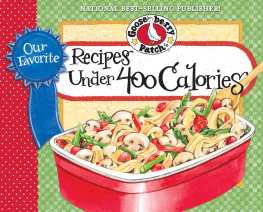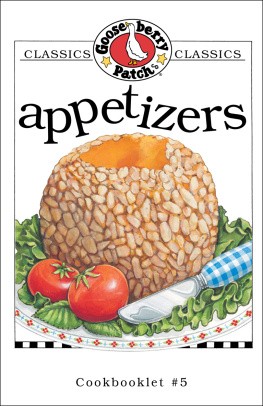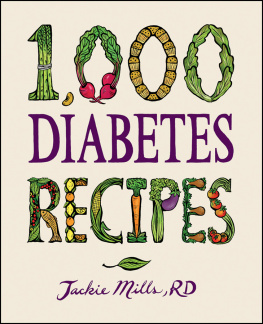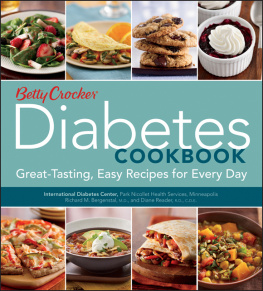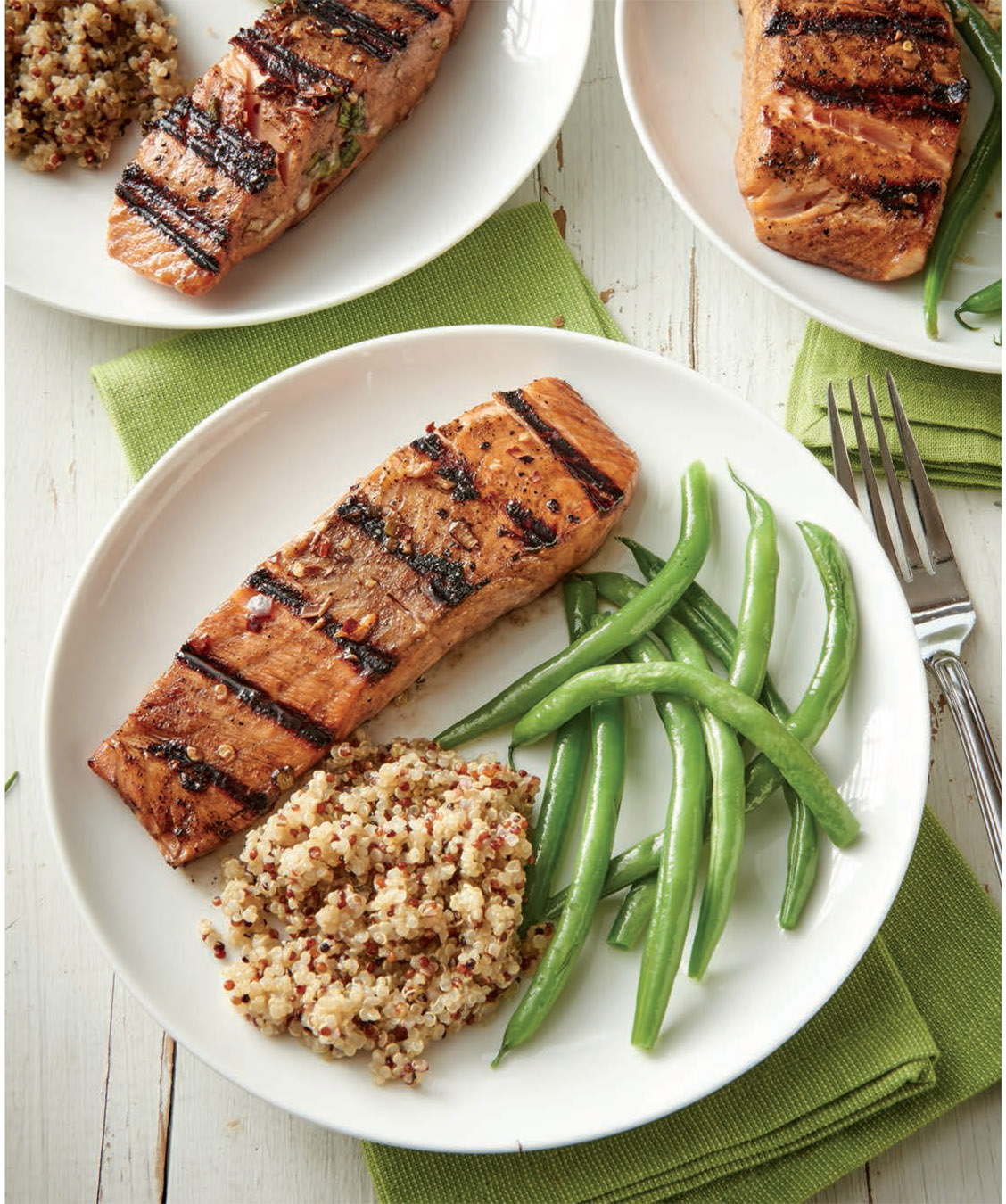Dedication
For every cook who wants to create diabetic-friendly recipes that the entire family will enjoy!
Appreciation
Thanks to everyone who shared their carb-smart, yet satisfying recipes with us!
Gooseberry Patch An imprint of Globe Pequot 246 Goose Lane Guilford, CT 06437 www.gooseberrypatch.com
18008546673 Copyright 2017, Gooseberry Patch
978-1-62093-266-7 All rights reserved. No part of this book may be reproduced or utilized in any form or by any means, electronic or mechanical, including photocopying and recording, or by any information storage and retrieval system, without permission in writing from the publisher. Printed in Korea.
Welcome
Dear Friends,
Many people think that getting diagnosed with diabetes means that the days of eating great-tasting fare are long gone and enjoying their favorite dishes is a thing of the past.
Gooseberry Patch Delicious Recipes for Diabeticsproves that this doesnt have to be the case, and people living with diabetes can eat satisfying food every meal of the day without any guilt.
This cookbook delivers over 315 carb-smart recipes with every sip and bite of the delightfulness youd expect from Gooseberry Patch.
Youll find recipes shared by cooks just like you and get the secrets from our food experts at Gooseberry Patch on how they lightened them to keep every last drop of yummy goodness while cutting calories, carbohydrates and fat. With every recipe meeting the American Diabetes Associations guidelines and having been reviewed and approved by a registered dietitian, you can rest assured knowing each dish is supremely healthy. Weve also included the nutrient analysis and diabetic exchanges with every recipe to help you select items that follow your personal diabetic meal plan. Inside youll find energy-boosting dishes like Moms Apple Omelet (page 48) to jump-start your day or Mediterranean Sandwiches (page 239) for a quick and satisfying lunch. Plus, recipes such as Chicken Cacciatore (page 166) or Eggplant Ratatouille (page 170) are perfect for a quick weeknight meal; you wont believe just how easy they are! Pair any of these main dishes with fresh-from-the-garden sides like Spicy Carrot French Fries (page 122) and Crunchy Green Bean Salad (page 102). We hope this cookbook will bring exciting new recipes to your cooking repertoire and youll discover the joy in making delicious meals for your family once again! Sincerely, Jo Ann & Vickie
Introduction
Diabetic Meals Made Easy
Once youve been diagnosed with type 1 or type 2 diabetes, learning how to plan meals that help control your blood glucose is essential.
We hope this cookbook will bring exciting new recipes to your cooking repertoire and youll discover the joy in making delicious meals for your family once again!Sincerely,
Jo Ann & VickieIntroduction
Diabetic Meals Made Easy
Once youve been diagnosed with type 1 or type 2 diabetes, learning how to plan meals that help control your blood glucose is essential.
But, that doesnt mean you have to give up the foods you love. It just means you may need to eat smaller portions of those foods and pair them with less carbohydrate and calorie dense items for balanced meals. To help you standardize your diet, your doctor may want you to start counting carbohydrates or begin using the exchange lists for diabetes. You may find their recommended method for monitoring what you eat is a little tricky to use at firstespecially if youre not in the habit of measuring your portions. But once you learn the correct portion sizes of dierent foods, youll discover it is an easy and effective dietary tool to keep your blood sugar within its target range. Carbohydrate Counting Because a carbohydrate is converted into glucose after eating it, carbohydrate counting is the best way to control how much glucose enters your bloodstream.
This meal-planning method is used by those who are taking insulin and is also very helpful for those who want tighter control over their blood sugar levels. To get you started using this tool, your doctor and dietitian will prescribe you a meal plan with a set amount of carbohydrate for meals and snacks. Youll count the grams of carbohydrate you eat making sure you dont exceed the recommended amount. Many people find that carbohydrate counting is the easiest diabetic meal-planning technique to implement because it only tracks one nutrient. Exchange Lists for Diabetes The exchange lists for diabetes are a meal-planning approach that is used to achieve a daily balance of carbohydrate, protein and fat intake. Diabetic exchanges are also useful for blood glucose control, and, unlike carbohydrate counting alone, using them daily will help you plan calorie-controlled and nutritionally-balanced meals.
This system is comprised of 6 different lists of foods categorized by their total calories and carbohydrate, protein and fat amounts. The various groups include fruit; vegetables; bread and starches; milk; meat and substitutes; and fat. The milk and meat and substitutes groups are further broken down into sub-groups based on calorie and fat content. Depending on your health goals, your doctor and dietitian will customize your daily meal plan with a set number of exchange choices from each list. Foods can be traded for another food on the same list, in the specified serving amount, but not between lists even if they have the same calorie count. The following are examples of exchanges within each list: Fruit One exchange contains 60 calories, 15 grams of carbohydrate and 0 grams of fat per serving.
Below are a few examples of what one exchange equals: c. dried fruit large grapefruit c. cubed pineapple 1 small banana Vegetables One exchange contains 25 calories, 5 grams of carbohydrate and 2 grams of protein per serving. Below are a few examples of what one exchange equals: c. cooked broccoli c. raw cucumber 1 c. salad greens Bread and Starches One exchange contains 80 calories, 15 grams of carbohydrate, 3 grams of protein and a trace amount of fat per serving. salad greens Bread and Starches One exchange contains 80 calories, 15 grams of carbohydrate, 3 grams of protein and a trace amount of fat per serving.
Below are a few examples of what one exchange equals: 1 (1-oz) slice of bread c. cooked rice or pasta c. cooked cereal c. cooked beans or lentils c. mashed potato Milk All exchanges from this list contain 12 grams of carbohydrate and 8 grams of protein per serving but the calorie and fat amounts differ among each subcategory. The subcategories for this exchange list with their calorie and fat per serving are: skim and very low-fat (90 calories and 0 to 3 grams of fat), low-fat (120 calories and 5 grams of fat), and whole (150 calories and 8 grams of fat).
Below are a few examples of what one exchange equals: 1 c. skim milk 1 c. whole milk c. nonfat plain yogurt c. plain yogurt Meat and Substitutes All exchanges from this list contain 7 grams of protein but the calorie and fat content differ among each category. The subcategories for this exchange list with their calorie and fat per serving are: very lean meat (35 calories and 0 to 1 grams of fat), lean meat (55 calories and 3 grams of fat), medium-fat meat (75 calories and 5 grams of fat) and high fat meat (100 calories and 8 grams of fat).




